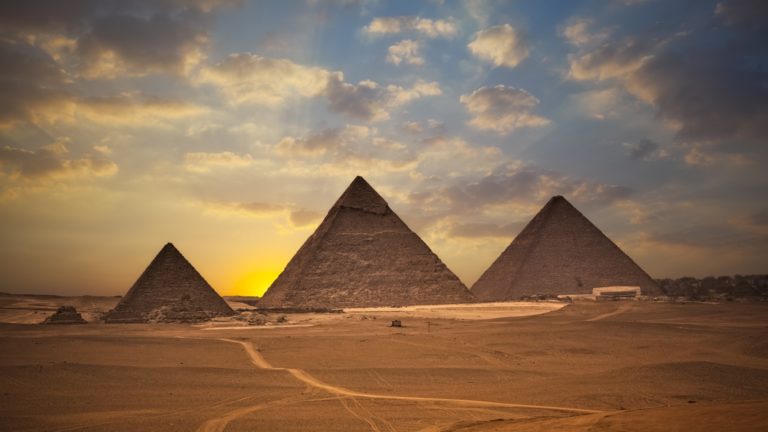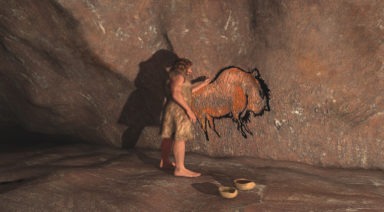Void Discovered in Great Pyramid; Is Mainstream Egyptology Still Credible?

The recent void discovered in the Great Pyramid of Giza has sparked curiosity and intrigue among both archeologists and the public alike. The media has portrayed the find as fascinating, mysterious, and a cause for further exploration, while prominent archeologists controlling the narrative are trying their hardest to curtail that excitement. Claiming that this is anything but a discovery, these archeological stalwarts want to prevent any challenge to what they believe is the truth behind the pyramids’ construction and purpose, while also covering up how little they really know.
Void Discovered in Great Pyramid
A few weeks ago, a project called ScanPyramids employed a technology that used cosmic radiation to X-ray the Great Pyramid of Giza, also known as the Pyramid of Khufu. The technology tracks muons, particles that are similar to electrons, but slightly heavier, as they bombard the Earth, penetrating matter and slowly decaying.
Using machines that can detect these particles, the team of scientists at ScanPyramids monitored muons hitting the pyramids, noticing an excess of energized particles in a particular spot inside the pyramid. This provided evidence of a void about 100-feet-long that could be anything from a chamber, to a tunnel, or just empty space.
This muon-monitoring machine isn’t novel, though the technology surrounding it is improving. It has been used since the 1960s when Dr. Luis Alvarez used the technology to search for chambers in the Chephren pyramid at Giza.

courtesy vox.com
Though they’re not making any extravagant claims about the discovery, while also using an ambiguous word to describe it, that hasn’t stopped others from completely invalidating their find. Zahi Hawass, the de facto mouthpiece of the Egyptian Ministry of Antiquities and the mainstream narrative of Egyptology, said that this recent discovery doesn’t contribute anything to our understanding.
“They found nothing. This paper offers nothing to Egyptology. Zero,” Hawass said.
Dictatorial Mainstream Narratives
Whether or not this discovery turns out to be profound or provides insight into how the pyramids were built, is somewhat irrelevant for the sake of this argument. What is relevant is the tone of Hawass’ statement and his completely discouraging sentiment.
Firstly, any previously unknown void inside the pyramid that hasn’t been explicitly mapped or included in the known schema is a discovery. Even if the void isn’t incredibly surprising because it was theorized or expected to be there, that doesn’t negate evidence of it’s existence and the fact that it was discovered. This type of attitude not only discourages action to investigate what the void could possibly be, but it also dampens any motivation to examine other areas of the pyramids that could have previously unknown characteristics.
Hawass’ statement is reflective of his authoritarian control of Egyptology in general. Over the course of his career, he’s come under considerable criticism, including legal action that almost resulted in jail time, for a number of transgressions related to his work. Known for his egocentricity and ostentatiousness, he has used his position to make a fortune, often ignoring conflicts of interest between his government role and private payments. Meanwhile, he’s known for denying credible archeologists the opportunity to study the pyramids, while punishing them for speculating about their discoveries without first deferring to him.

He has a reputation of holding a tyrannical rule over Egyptology, while commanding media coverage, and taking credit for discoveries without mentioning the organizations that funded them. He’s bypassed major museums that refuse to charge extra for what he deems to be exceptional exhibits, while also endangering Egyptian antiquities by shipping them overseas without the Egyptian government’s consent.
It is this type of attitude controlling the narrative around ancient Egypt and the pyramids, that is so quick to cast doubt on any new and exciting discoveries. At the same time, Hawass is credited with changing the perception of Egyptology from a dull, abstract study to the exciting and mysterious reputation it has today. Just as long as he’s at the forefront of any major revelations.
The Convoluted Concepts of Construction
Whether one accepts the dominant narrative that the pyramids were built by the Egyptians for Pharaoh Khufu or some alternative theory, boils down to personal belief, but the reality is that there isn’t a truly solid explanation that is widely agreed upon. There are holes in every theory and often the competing ones are devised by archeologists with limited understanding of engineering or vice versa.
The story that most of us were taught in school involves the slave labor of thousands of men moving massive stone blocks, chiseled by wooden mallets, that were then somehow dragged up a ramp to construct a 455-foot pyramid. We were told that it was built as a tomb for this mysterious pharaoh, of whom little is known, and filled with all the necessary accoutrements for his journey in the afterlife.
What we weren’t told is that the whole theory of the pyramid’s construction being ordered by and for Khufu, is based on one piece of potentially spurious evidence, found by a man who was running out of funding and desperate to make a discovery. Could Richard Vyse have forged the cartouche that supposedly marked the Great Pyramid as Khufu’s? Probably.

The other details that are left out are the numbers that show just how astounding it would have been for a civilization that didn’t use wheels to construct such a gargantuan and perfectly engineered structure. The fact that 2.3 million stone blocks, ranging from 2.5 to 80 tons, were transported 500 miles before even being set into place is astounding. And we’re told that the pyramid was built in about 20 years, meaning tens of thousands of laborers would have had to work both night and day, setting one stone in place about every 3-5 minutes to achieve this feat.
While they were moving these massive stones with very primitive technology, there had to have been many highly talented engineers overseeing the process so that they could achieve the perfect orientation and accuracy of its dimensions, an accomplishment that would be incredibly difficult today with modern technology.
The Great Pyramid is oriented precisely to the true cardinal directions, just slightly off by 4/60th of a degree. The opening of the joints between the massive stone blocks is on average 0.5 millimeters wide. The ratio of the perimeter to the height of the pyramid is accurate to better than 0.05%. And the base of the pyramid is completely flat to within 0.6 inches.
This comprehension of mathematics is mindboggling, as is the fact that there was no discovery of the concept of pi for another couple thousand years, but they would have had to use it with this level of construction. Even the ancient Greeks debated over how the pyramids were built, after Herodotus visited ancient Egypt in 450 B.C. He returned believing “machines” were involved, though it’s unclear what those machines were.
This is the information that isn’t often mentioned or known by the vast majority of people, who simply take it as fact that a primitive society was able to manage such an engineering marvel. Was it actually possible to execute this with such basic technology? Maybe. But there seems to be some piece of the puzzle missing, and discouraging the search for the truth is not beneficial to anyone, except those who wish to control the narrative for their own personal reasons or a larger, concerted restriction of knowledge.
Is Ezekiel's Vision of the Wheel Evidence of UFOs in the Bible?

Of the many accounts in the Bible of strange happenings and otherworldly occurrences, the story of the prophet Ezekiel is one of the more fascinating, especially when looked at through the lens of modern technology. When biblical texts are interpreted through this perspective in general, an interesting picture emerges of the possibility that our ancient ancestors were actually visited by an advanced race, rather than gods.
This idea, known as the ancient astronaut theory, interprets Ezekiel’s “vision” of the Merkabah, or wheeled chariot, as more likely to be a spaceship used by an advanced species to traverse outer space and make contact.
Erich von Däniken is one of the biggest proponents of this theory, providing a very compelling argument for an alternative interpretation of the Book of Ezekiel. So, compelling that his theory even reversed the entire thesis of a NASA scientist’s book aimed at disproving his claim.




































